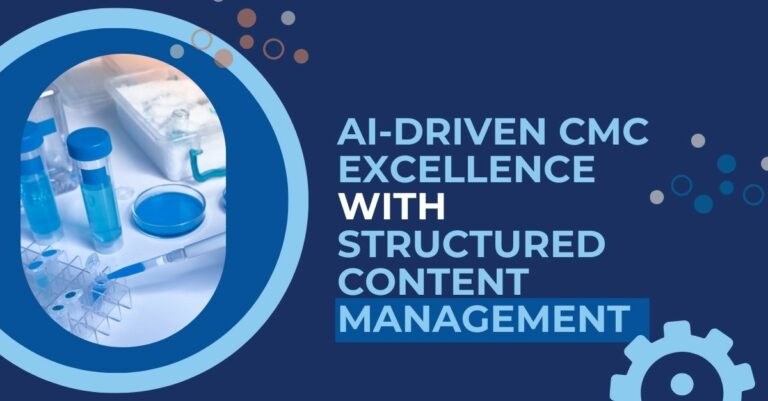
The convergence of AI and structured content management (SCM) in Chemistry Manufacturing and Controls (CMC) Module 3 offers a profound shift in pharmaceutical documentation.
This blog unveils the impact of AI-powered structured content management on CMC outputs, emphasizing efficiency, compliance, and innovation. We will delve into the significance of CMC outputs, the synergy of SCM with natural language technologies (NLT) and generative AI, and its transformative effect on streamlining CMC processes. Beyond mere efficiency, SCM fosters collaborative excellence, ensuring accuracy and consistency.
Understanding the Significance of CMC Outputs
Imagine the intricate dance of pharmaceutical development. At its core lies the CMC module, where meticulous documentation ensures the safety, efficacy, and quality of every drug. This information is orchestrated by four critical outputs:
Examples of CMC Outputs Generated Using SCM
Analytical Procedure (AP): This detailed guide outlines how specific tests are conducted, offering a roadmap for product testing. It meticulously defines the procedures and methodologies required.
Testing Specification (TS): Linked to AP, TS specifies the tests for drug products, guiding the evaluation criteria for their success. It establishes the standards for determining the fitness of test outcomes.
Validation Report (VR): This report is a critical checkpoint. An independent reviewer ensures the accuracy of steps outlined in the analytical procedure, providing an additional layer of assurance.
These interconnected components lay the foundation of product testing, setting evaluation criteria, precisely outlined procedures, and ultimately, the unyielding quality of life-saving medications. The nuanced details within these documents guide laboratories on how to test products, forming an integral part of testing specifications once the AP and VR are complete. However, managing them traditionally can pose concerns with version control, inconsistencies, and compliance.
Using the benefits of structured content authoring enables the consolidation of multiple documents to effortlessly generate easy-to-use reports like test specification reports.
Test Specification Report (TSR): A comprehensive collation of AP, TS, and VR, presented in a single PDF. This streamlined report with bookmarks ensures quick access to pertinent information.
Structured Content Management Meets NLT and Generative AI
There has been a ton of advancement in structured content management and current solutions offer much more capability than years past. One way structured content management systems are being further optimized is with the end-to-end integration of natural language technology and generative AI capabilities.
Natural language technologies (NLTs) are used to consume content that lives behind your firewall like data, stability summaries, and outputs, as well as data that lives in the public domain. This model allows for standardized data across the various sources and repositories. Natural language processing (NLP) provides the scale to consume massive volumes of data in hours, which would typically take humans weeks or months. NLP can read both structured and unstructured data and harmonize them into one structured data repository.
Generative AI takes the newly structured data and analyzes data patterns and information to populate output templates like the CTD or sections specific to module 3.
Humans are kept in the loop of the NLP & generative AI and have total control over the text output and algorithms to ensure accuracy and constant improvement of the AI-generated documentation.
This approach improves the lives of regulatory professionals by generating output drafts faster and more error-free, enabling them to focus their time on more valuable tasks.
These AI-generated CMC outputs can be worked in Microsoft Word or passed downstream to a structured content management system. This can be in current formats or in the emerging FHIR standard.
Streamlining CMC Processes with Structured Content Management
In the pharmaceutical realm, unwavering compliance is not a suggestion – it’s a demand. Integrating SCM into CMC processes signifies more than a technological shift; it represents a fundamental change in how pharmaceutical documentation is created, shared, and approved.
Accelerated authoring is facilitated for content authors through structured templates and generative AI, significantly reducing the time and effort required for creating comprehensive outputs. Such templates are predefined and configured for CMC processes using NLP. These documents can then be fed into Laboratory Information Management Systems (LIMS) where the actual product will be tested.
When authors are ready, they can select the template for their output of choosing (ie. AP, TS, VR) and a window will appear to choose which phrases they’d like to select per the available options of that section. This results in a more streamlined and standardized approach to creating highly regulated content. Pharmaceutical professionals can focus on content creation and reuse content from a single-source-of-truth CCMS repository, without the hassle of starting from scratch.
SCM’s robust infrastructure integrates consistent reuse of approved content, ensuring that the language used throughout the documentation aligns precisely with regulatory guidelines. This means no more ambiguity or misinterpretations due to inconsistent language. With SCM’s secure structure, pharmaceutical companies can confidently navigate the complex landscape of regulatory compliance, fostering a culture of precision and reliability in their CMC processes.
Beyond Efficiency: Collaborative Excellence and Seamless Control with SCM
SCM’s magic extends far beyond mere efficiency. It breaks down the silos that often hinder efficient teamwork.
Picture a shared platform where scientists, quality assurance experts, and regulatory professionals collaborate in real time, their expertise weaving together to produce high-quality documentation. Consistent phrase libraries, facilitated by SCM, ensure regulatory adherence, further enhancing accuracy and consistency. Real-time collaboration and feedback mechanisms empower teams to work cohesively and seamlessly, regardless of geographical constraints.
No more information silos, just a harmonious process of experts building quality and compliant documents.
The robust version control capabilities also take center stage with SCM. Robust tracking of changes, updates, and revisions ensures a clear audit trail, eliminating the mystery of “who changed what, and when?”
Automated workflows streamline approval processes, managing components and document versions independently. This means that compliance is enforced through versions and lifecycles configured by document type. This feature becomes a vital component in maintaining a comprehensive and traceable document history, eliminating bottlenecks and ensuring a more efficient progression from creation to approval.
The Future of CMC Documentation
As technology evolves, so does the need to develop more accurate, consistent, and compliant CMC documentation. Looking ahead, technological advancements in AI and structured content management promise more streamlined and optimized CMC processes. Continuous innovation in artificial intelligence, integrations with other systems, and more sophisticated content creation and collaboration tools are on the horizon.
Industry experts have anticipated a future where SCM technologies evolve to meet the ever-changing needs of the pharmaceutical industry and we are already seeing that with AI-powered structured content’s ability to adapt to evolving regulatory requirements. Imagine industry-tailored solutions that anticipate a landscape where CMC processes are not just reactive but adaptive. SCM becomes a trigger for optimized workflows, offering an agile, compliant, and innovative future. No longer a passive tool, SCM becomes a conductor, orchestrating a flawlessly executed performance assisted by AI.
Conclusion
In conclusion, adopting structured content management in addition to generative AI and NLTs in CMC brings multifaceted advantages. Beyond the technicalities, it reshapes how pharmaceutical teams collaborate, ensuring efficiency, compliance, and innovation.
As industries navigate the dynamic landscape of pharmaceutical development, SCM stands as a catalyst for optimized CMC processes. It’s not just a technological shift; it’s a transformative journey toward a more agile, compliant, and innovative future.
For those considering the adoption of SCM in CMC, reaching out to industry experts is paramount. Solutions like ComplianceAuthor AI, tailored for pharmaceuticals and life sciences, offer a comprehensive suite of tools designed to meet the specific needs of the industry. For more information, it’s recommended to consult with industry experts for support and implementation tailored to your organization’s unique requirements.
Want to use AI to improve the efficiency of your CMC outputs? Contact Glemser today to get started.


